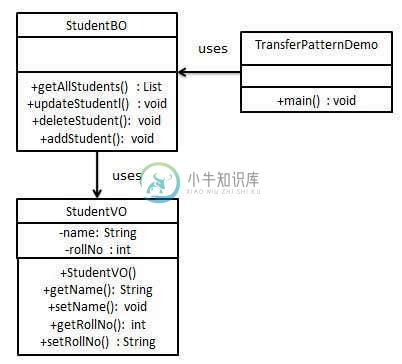传输对象模式(Transfer Object Pattern)
优质
小牛编辑
134浏览
2023-12-01
当我们想要从客户端到服务器一次性传递具有多个属性的数据时,使用传输对象模式。 传输对象也称为值对象。 Transfer Object是一个简单的POJO类,具有getter/setter方法,并且是可序列化的,因此可以通过网络传输。 它没有任何行为。 服务器端业务类通常从数据库中提取数据并填充POJO并将其发送到客户端或按值传递。 对于客户端,传输对象是只读的。 客户端可以创建自己的传输对象并将其传递给服务器,以便一次性更新数据库中的值。 以下是此类设计模式的实体。
Business Object - 业务服务使用数据填充传输对象。
Transfer Object - 简单的POJO,具有仅设置/获取属性的方法。
Client - 客户端请求或将传输对象发送到业务对象。
实现 (Implementation)
我们将创建一个StudentBO作为业务对象, Student作为转移对象来表示我们的实体。
TransferObjectPatternDemo ,我们的演示类,在这里充当客户端,将使用StudentBO和Student来演示传输对象设计模式。

Step 1
创建传输对象。
StudentVO.java
public class StudentVO {
private String name;
private int rollNo;
StudentVO(String name, int rollNo){
this.name = name;
this.rollNo = rollNo;
}
public String getName() {
return name;
}
public void setName(String name) {
this.name = name;
}
public int getRollNo() {
return rollNo;
}
public void setRollNo(int rollNo) {
this.rollNo = rollNo;
}
}
Step 2
创建业务对象。
StudentBO.java
import java.util.ArrayList;
import java.util.List;
public class StudentBO {
//list is working as a database
List<StudentVO> students;
public StudentBO(){
students = new ArrayList<StudentVO>();
StudentVO student1 = new StudentVO("Robert",0);
StudentVO student2 = new StudentVO("John",1);
students.add(student1);
students.add(student2);
}
public void deleteStudent(StudentVO student) {
students.remove(student.getRollNo());
System.out.println("Student: Roll No " + student.getRollNo() + ", deleted from database");
}
//retrive list of students from the database
public List<StudentVO> getAllStudents() {
return students;
}
public StudentVO getStudent(int rollNo) {
return students.get(rollNo);
}
public void updateStudent(StudentVO student) {
students.get(student.getRollNo()).setName(student.getName());
System.out.println("Student: Roll No " + student.getRollNo() +", updated in the database");
}
}
Step 3
使用StudentBO演示传输对象设计模式。
TransferObjectPatternDemo.java
public class TransferObjectPatternDemo {
public static void main(String[] args) {
StudentBO studentBusinessObject = new StudentBO();
//print all students
for (StudentVO student : studentBusinessObject.getAllStudents()) {
System.out.println("Student: [RollNo : " + student.getRollNo() + ", Name : " + student.getName() + " ]");
}
//update student
StudentVO student = studentBusinessObject.getAllStudents().get(0);
student.setName("Michael");
studentBusinessObject.updateStudent(student);
//get the student
student = studentBusinessObject.getStudent(0);
System.out.println("Student: [RollNo : " + student.getRollNo() + ", Name : " + student.getName() + " ]");
}
}
Step 4
验证输出。
Student: [RollNo : 0, Name : Robert ]
Student: [RollNo : 1, Name : John ]
Student: Roll No 0, updated in the database
Student: [RollNo : 0, Name : Michael ]

